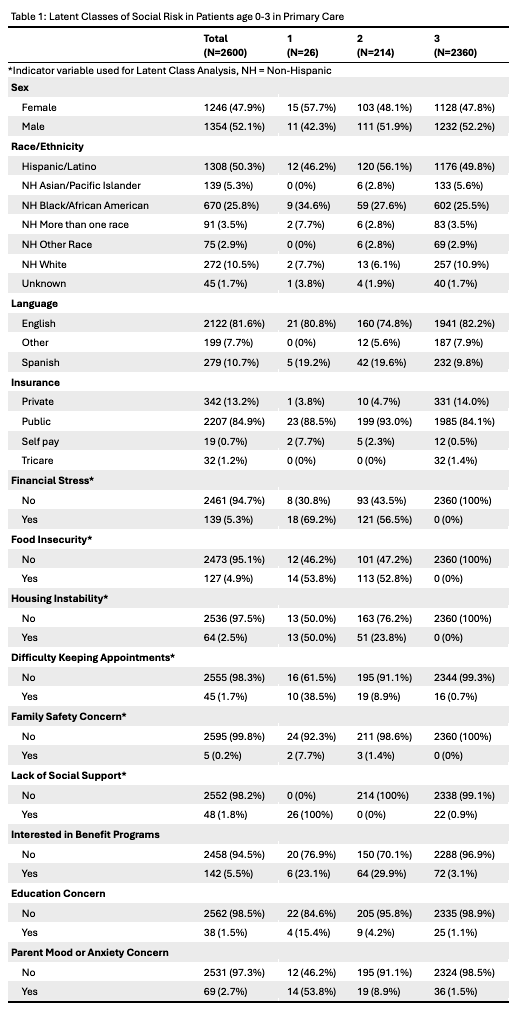Health Equity/Social Determinants of Health 7
Session: Health Equity/Social Determinants of Health 7
743 - Identifying Categories of Social Risk in a Pediatric Primary Care Setting Using Latent Class Analysis
Sunday, April 27, 2025
8:30am - 10:45am HST
Publication Number: 743.5336
Michael Mattiucci, University of Colorado School of Medicine, Aurora, CO, United States; Yaxu Zhuang, University of Colorado School of Medicine, Aurora, CO, United States; Sana Yousuf, Children's Hospital Colorado, Denver, CO, United States; Elizabeth Bayliss, Institute for Health Research, Kaiser Permanente Colorado, Aurora, CO, United States; Lisa R. DeCamp, Children's Hospital Colorado | University of Colorado, Aurora, CO, United States
- MM
Michael Mattiucci, MD/MPH (he/him/his)
Instructor/Fellow
University of Colorado School of Medicine
Aurora, Colorado, United States
Presenting Author(s)
Background: Social risk screening is increasingly being implemented in health care settings. However, little is known about how to identify categories of social risk in pediatric patients and their families. Distinguishing categories of social risk may be useful for tailoring interventions for specific groups within a population.
Objective: To identify distinct categories of social risk in children age 0-3 in pediatric primary care using Latent Class Analysis, to guide tailoring of social care intervention strategies.
Design/Methods: We created a dataset using electronic health record data at a large, academic primary care clinic in Aurora, CO. Inclusion criteria were: patients age 0-3 who had a well child visit (WCV) between 10/1/21 and 3/31/22 with a social risk screening tool completed, and who had at least one additional WCV with social risk screening between 4/1/22 and 3/31/24. Indicator variables for latent class analysis (LCA) were drawn from the clinic’s standard social risk screening tool at the patient’s index visit and include: 1) food insecurity, 2) housing instability, 3) financial stress, 4) family safety, 5) difficulty keeping appointments, and 6) lack of social support. Analysis was performed in R using polytomous variable LCA. Models were compared using Bayesian Information Criterion and Akaike Information Criterion. A final model was chosen based on these fit criteria and pertinence to tailoring of social care interventions. Fisher exact testing was used to examine differences between classes.
Results: LCA identified three social risk classes (Table 1): High social risk and low social support (Class 1, 1.0% of sample), Moderate social risk (Class 2, 8.2%) and Low social risk (Class 3, 90.8%). Class 1 is defined by the presence of low social support, and compared to Class 2 has higher frequencies of parental mood and anxiety symptoms, housing instability, difficulty keeping appointments, and education concerns (p < 0.05). Class 2 has high financial stress and food insecurity, with moderate housing instability and difficulty keeping appointments. Class 3 has low or absent reported social risk factors.
Conclusion(s): Distinct classes of social risk exist in families of children age 0-3 in an urban primary care setting, highlighting the potential for tailored interventions. A small group of patients with significantly elevated social risk is distinguished by low social support and parental mental health concerns. This group may benefit from more targeted interventions to address parental mental health and social isolation in addition to screening and referral for social needs.
Table 1
 Latent Classes of Social Risk in Patients Age 0-3 in Primary Care
Latent Classes of Social Risk in Patients Age 0-3 in Primary Care
